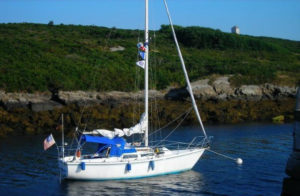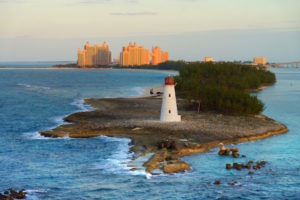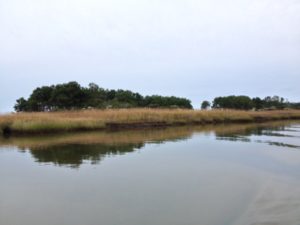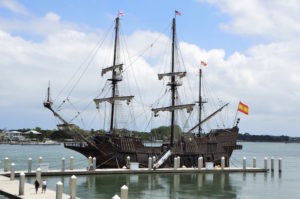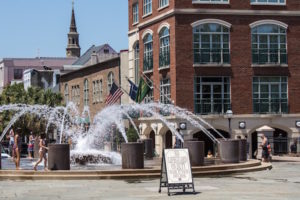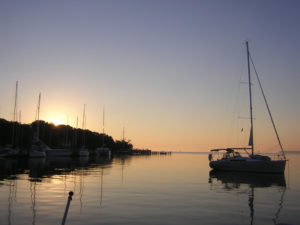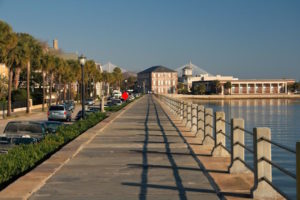A used sailboat costs about as much as a used car. It won’t be new, and it may be a long-term project, but you can sail into the dream for less than $20,000.
Our dream turned out to be a 1982 Catalina, a 27-foot sloop with a cranky inboard Atomic 4 gasoline engine and just enough room and furnishings for two; these included a two-burner stove, a sink and toilet with a door.
My companion and captain, Phil, woke from a dream and suddenly sat upright in bed with a Bob Seger song blaring in his head. “Catmandu!” he said. “We’ll name it Catmandu” (spelled with a C because we have a cat).
To begin: Get off the dock
Phil learned to crew boats in high school in Minnesota, but came to skippering much later. A neighbor “ruined my life,” he says, “by taking me to the Bahamas on his sailboat.” Phil was hooked.
They sailed from Florida, across the wild Gulfstream, to the Atlantis resort in Nassau. There is a marina there, where it is cheaper to dock a boat than to get two hotel rooms.
There are also Caribbean vacation spots where anyone can visit the marinas and get a feel for a cruising life.
After buying Catmandu, Phil took a three-day University of New Hampshire small-boat sailing course, and when I began to accompany him, he insisted I take the Coast Guard Auxiliary safe boating course.
This is a must. You will learn how to read a chart and the rules of the road, how to use the VHF radio without embarrassing yourself and how to tie a few essential knots, including the cleat hitch, which holds the boat to the dock.
If you’re interested in sailing the islands, booking a cheap Bahamas vacation package would be a good way to start, then take lessons while there. Sailing clubs, universities and private companies also offer courses.
It’s best to learn on small boats where the principles of sailing are obvious and straightforward, and a mistake setting the sail will merely dump you (safely) into the water. Sailing clubs are a great idea, too, because you’ll have an opportunity to sail what we call “OPB,” other people’s boats.
Along the Intracoastal Waterway
After a few years sailing the rough waters off Maine’s coast, Phil took a job in the Washington, D.C., area. He decided to sail the boat there and live on it full time.
This is not uncommon; we met many others who had chosen this lifestyle. Some were retired, but many worked at odd jobs, writing articles or blogs, and some took temporary jobs.
In most marinas, it’s cheaper to live on your paid-for boat than to rent an apartment on land. This was certainly true in D.C.
Later, Phil’s job allowed him to settle anywhere in the U.S. and work from home. So, we moved to Fort Lauderdale where the sailing season lasts all year.
We joined the Seven Seas Cruising Association (SSCA), a global organization of sailors. It conducts “gams,” or educational get-togethers, with seminars on all things sailing: anchoring, navigating, weather, boat maintenance and more.
We sailed to the Chesapeake to attend our first gam, and to meet up with other cruisers who were headed south on the Intracoastal Waterway, or ICW.
The ICW is a narrow East Coast waterway — actually, a canal, connecting rivers and bays — located a few miles inland from the ocean.
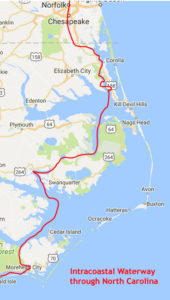
A map of the Intracoastal Waterway, at least, part of it, showing its inland route not so far from the Atlantic Ocean.
Catmandu is a coastal cruiser and not built for crossing ocean waters, but the rivers and canals of the ICW are perfect for this size boat.
The waterway took us through some of the most primitive wilderness I’ve ever seen, with eagles, vast acres of savannah, grassy islands with sand beaches and the friendly towns of Florida, Georgia, the Carolinas and Virginia.
We anchored in small town harbors, marinas where we met other cruisers, and in tiny rural inlets. In many places, we were totally alone, with not even a light on the horizon. One night, we were visited by dolphins; they scared us with their human-like gasps of breath as they slept next to our boat.
Getting to the Caribbean
These days, we are getting to know the islands by taking cheap cruises to the Caribbean and exploring.
Our next boat will be the one we sail to these tropical ports. We dream of something a little larger and more stable, with a shower and a refrigerator.
We will cross the Gulfstream and anchor in tiny harbors where the water is bright aqua blue. We will swim from deserted beaches and snorkel in the shallow reefs. We will never miss a sunrise or sunset from the cockpit of our second boat. It will probably also be named “Catmandu.”
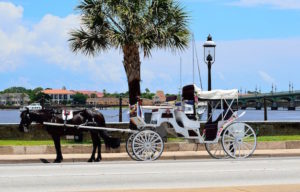
For more on our journey along the Intracoastal Waterway: Carriages offer a popular way to see St. Augustine, Fla.
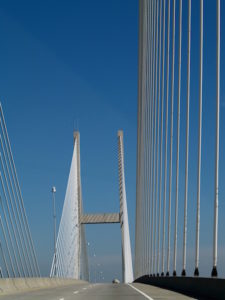
On our route, too: The striking Sidney Lanier Bridge seen at Jekyll Island, one of Georgia’s barrier islands.
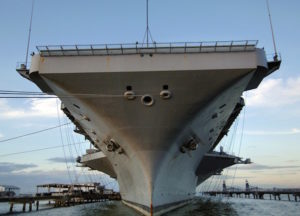
The aircraft carrier, the USS Harry S. Truman, homeported in Norfolk, Va. We saw numerous giant naval vessels here.
Kay D. Harrison, this blog’s author, was formerly a journalist on the Concord (N.H.) Monitor staff and a copy editor for Simon & Schuster. Currently, she develops content for Dunhill Travel Deals, and — an avid sailor — she writes her own sailing blog, Under the Boom (https://undertheboom.com). Dunhill Travel Deals selects and publishes the industry’s best deals in a newsletter and at its Web site (www.dunhilltraveldeals.com).

